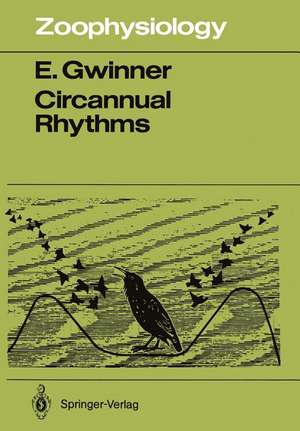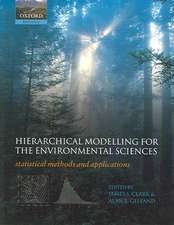Circannual Rhythms: Endogenous Annual Clocks in the Organization of Seasonal Processes: Zoophysiology, cartea 18
Autor Eberhard Gwinneren Limba Engleză Paperback – 8 dec 2011
Din seria Zoophysiology
- 15%
 Preț: 647.92 lei
Preț: 647.92 lei - 15%
 Preț: 638.76 lei
Preț: 638.76 lei - 15%
 Preț: 638.24 lei
Preț: 638.24 lei - 15%
 Preț: 641.38 lei
Preț: 641.38 lei - 15%
 Preț: 634.82 lei
Preț: 634.82 lei -
 Preț: 386.61 lei
Preț: 386.61 lei - 15%
 Preț: 636.94 lei
Preț: 636.94 lei - 15%
 Preț: 640.88 lei
Preț: 640.88 lei - 15%
 Preț: 637.78 lei
Preț: 637.78 lei - 15%
 Preț: 640.88 lei
Preț: 640.88 lei -
 Preț: 386.61 lei
Preț: 386.61 lei - 15%
 Preț: 637.78 lei
Preț: 637.78 lei - 15%
 Preț: 638.24 lei
Preț: 638.24 lei - 15%
 Preț: 642.83 lei
Preț: 642.83 lei - 15%
 Preț: 634.68 lei
Preț: 634.68 lei - 15%
 Preț: 642.83 lei
Preț: 642.83 lei - 18%
 Preț: 999.60 lei
Preț: 999.60 lei - 15%
 Preț: 639.41 lei
Preț: 639.41 lei - 15%
 Preț: 638.43 lei
Preț: 638.43 lei - 15%
 Preț: 651.34 lei
Preț: 651.34 lei - 15%
 Preț: 638.57 lei
Preț: 638.57 lei - 15%
 Preț: 637.46 lei
Preț: 637.46 lei - 15%
 Preț: 637.59 lei
Preț: 637.59 lei - 15%
 Preț: 641.53 lei
Preț: 641.53 lei - 15%
 Preț: 636.80 lei
Preț: 636.80 lei -
 Preț: 386.22 lei
Preț: 386.22 lei - 15%
 Preț: 632.55 lei
Preț: 632.55 lei - 15%
 Preț: 695.19 lei
Preț: 695.19 lei -
 Preț: 401.24 lei
Preț: 401.24 lei - 18%
 Preț: 942.01 lei
Preț: 942.01 lei - 18%
 Preț: 945.30 lei
Preț: 945.30 lei - 15%
 Preț: 652.17 lei
Preț: 652.17 lei - 15%
 Preț: 632.70 lei
Preț: 632.70 lei - 15%
 Preț: 640.71 lei
Preț: 640.71 lei - 15%
 Preț: 644.30 lei
Preț: 644.30 lei - 15%
 Preț: 642.68 lei
Preț: 642.68 lei
Preț: 635.47 lei
Preț vechi: 747.61 lei
-15% Nou
Puncte Express: 953
Preț estimativ în valută:
121.59€ • 126.96$ • 100.64£
121.59€ • 126.96$ • 100.64£
Carte tipărită la comandă
Livrare economică 04-18 aprilie
Preluare comenzi: 021 569.72.76
Specificații
ISBN-13: 9783642828720
ISBN-10: 3642828728
Pagini: 172
Ilustrații: XII, 156 p.
Dimensiuni: 170 x 244 x 9 mm
Greutate: 0.28 kg
Ediția:Softcover reprint of the original 1st ed. 1986
Editura: Springer Berlin, Heidelberg
Colecția Springer
Seria Zoophysiology
Locul publicării:Berlin, Heidelberg, Germany
ISBN-10: 3642828728
Pagini: 172
Ilustrații: XII, 156 p.
Dimensiuni: 170 x 244 x 9 mm
Greutate: 0.28 kg
Ediția:Softcover reprint of the original 1st ed. 1986
Editura: Springer Berlin, Heidelberg
Colecția Springer
Seria Zoophysiology
Locul publicării:Berlin, Heidelberg, Germany
Public țintă
ResearchCuprins
1. Introduction.- 1.1 The Phenomenon of Annual Rhythmicity.- 1.2 Ultimate and Proximate Factors in the Control of Annual Rhythms.- 1.3 Circannual Rhythms.- 1.4 Hierarchical Organization of Proximate Factors.- 1.5 Early Suggestions of Circannual Rhythms.- 1.6 Some Definitions and Delimitations.- 2. Evidence for Circannual Rhythms.- 2.1 Typical Cases.- 2.2 Atypical Cases.- 3. Properties of Free-Running Circannual Rhythms.- 3.1 Degree of Persistence and Range of Permissive Conditions.- 3.2 Range of Circannual Period Length and Transients.- 3.3 Dependence of Period on External Conditions.- 3.4 Innateness of Circannual Rhythms.- 3.5 Comparison with Circadian Rhythms.- 4. Synchronization of Circannual Rhythms.- 4.1 Zeitgebers.- 4.2 Ranges of Entrainment.- 4.3 Behavoir Within the Range of Entrainment.- 4.4 Comparison with Circadian Rhythms and Some Conclusions.- 5. Mechanisms of Circannual Organization.- 5.1 Interactions with the Circadian System.- 5.2 Interrelationship Among Different Circannual Functions. Or: One or Several Circannual Clocks?.- 5.3 Components of Specific Circannual Functions.- 5.4 Conclusions.- 6. Adaptive Significance of Circannual Rhythms.- 6.1 General Advantages of Circannual Rhythms.- 6.2 Specific Functions of Circannual Timing Mechanisms.- 6.3 Conclusions and Perspective.- Appendix. General Oscillator Model and Terminology.- References.- Systematic Index.
















